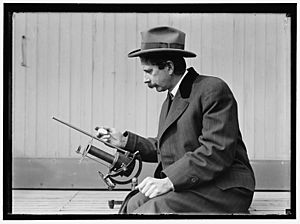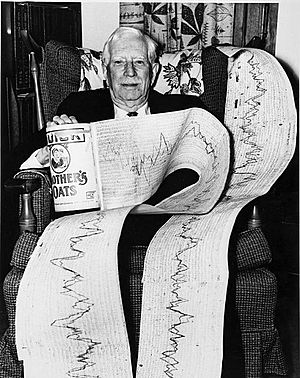Charles Greeley Abbot facts for kids
Quick facts for kids
Charles Greeley Abbot
|
|
|---|---|
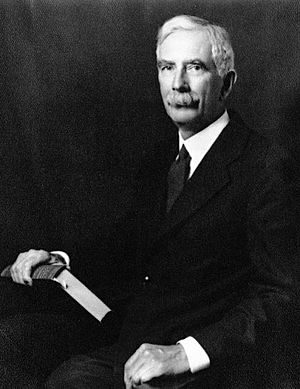
Dr. Charles Greeley Abbot
|
|
| 5th Secretary of the Smithsonian Institution | |
| In office 1928–1944 |
|
| Preceded by | Charles Doolittle Walcott |
| Succeeded by | Alexander Wetmore |
| Personal details | |
| Born | May 31, 1872 Wilton, New Hampshire |
| Died | December 17, 1973 (aged 101) Riverdale, Maryland, U.S. |
| Nationality | American |
| Spouses | Lillian Elvira Moore Abbot (m. 1897–1944; death), Virginia Andes Johnson (m. 1954–1973; death) |
| Alma mater | Phillips Academy, Massachusetts Institute of Technology (BS) |
| Known for | Astrophysics |
Charles Greeley Abbot (born May 31, 1872 – died December 17, 1973) was an American astrophysicist. He was the fifth leader, or Secretary, of the Smithsonian Institution. He served in this role from 1928 to 1944.
Abbot started his career as a director at the Smithsonian Astrophysical Observatory. He then became an Assistant Secretary. Later, he became the main Secretary of the Smithsonian. As an astrophysicist, he studied the sun's energy. This research led him to invent many things. These included the solar cooker, solar boiler, and solar still. He also held other patents for solar energy inventions.
Contents
Growing Up and School
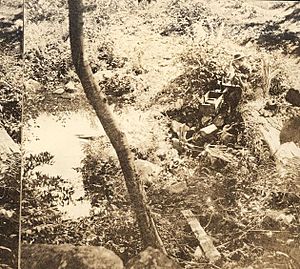
Charles Greeley Abbot was born in Wilton, New Hampshire. His parents, Harris Abbot and Caroline Ann Greeley, were farmers. Charles was the youngest of their four children. When he was young, he loved to build and invent things. He made a forge to fix tools. He also built a water wheel to power a saw. He even made a bicycle!
At 13, he left school to work as a carpenter. But two years later, he went back to high school. He attended Phillips Academy.
A friend of his planned to take an entrance exam for the Massachusetts Institute of Technology (MIT). Charles went along just to visit Boston. But once there, he felt uncomfortable exploring alone. So, he decided to take the exam too. He passed! His family worked hard to gather money to send him to MIT for one year. He first studied chemical engineering. But he later switched to physics.
He earned his Master of Science degree in physics in 1894. While in Boston, Abbot met Samuel P. Langley at MIT. Langley was looking for an assistant. In 1895, Abbot began working as an assistant at the Smithsonian Astrophysical Observatory.
Working at the Smithsonian Astrophysical Observatory
At the Smithsonian Astrophysical Observatory (SAO), Abbot worked with Samuel P. Langley. Langley later changed his focus from studying the sun's energy to aeronautics (the science of flight). Abbot then took over the solar energy research.
Abbot went on many expeditions for his research. In 1900, he and Langley traveled to Wadesboro, North Carolina. They went to observe a solar eclipse. In 1901, they went on another eclipse trip to Sumatra. During his travels, he also visited Algeria, Egypt, South Africa, and Australia. He often worked with the National Geographic Society.
Abbot became the acting director of SAO in 1906. In 1907, after Langley's death, Abbot became the official Director. Langley had thought Mount Whitney would be a great place for an observatory. Abbot got the money needed, and the observatory was built there in 1909.
As Director, Abbot opened the Radiation Biology Laboratory in 1929. This lab studied how radiation affects plants and other living things. This helped start the field of biophysics in the United States. Abbot remained Director until he retired.
Leading the Smithsonian Institution
In 1918, Abbot became the Assistant Secretary at the Smithsonian Institution. He took on this role after Frederick W. True passed away. As Assistant Secretary, he managed the Smithsonian Institution Libraries. He also oversaw the International Exchange Service and the SAO. He helped create the Smithsonian Scientific Series books. These books helped raise money for the Smithsonian.
Ten years later, on January 10, 1928, Abbot became the fifth Secretary of the Smithsonian. This happened after Charles Doolittle Walcott died. Abbot also kept his job as Director of the Astrophysical Observatory. In 1927, Walcott had finished the Smithsonian's main plan for the future. Abbot took on this plan when he became Secretary.
The Smithsonian started a fundraising effort in 1929. This was at the same time the Great Depression began. During his time as Secretary, Abbot guided the Smithsonian's involvement in Works Progress Administration projects. These projects included new buildings and art at the National Zoo. He also started the Smithsonian's first media project. It was a radio show called The World is Yours. The show stopped in 1942 because of World War II.
In the 1930s, a plan to expand the National Museum of Natural History building was approved. This expansion did not begin until the 1960s. The Institute for Social Anthropology also joined the Smithsonian during this time. While Secretary, Abbot tried to get the National Gallery of Art for the Smithsonian, but he was not successful. His role in the United States National Museum was small. Assistant Secretary Alexander Wetmore mainly managed it.
Charles Abbot was the first Smithsonian Secretary to retire. He left his position on July 1, 1944. After retiring, he was given the title Secretary Emeritus. This meant he could continue his research work. The first Smithsonian holiday party was held during his time as Secretary. At the party, Abbot sang and played the cello. While in Washington, he was a deacon at the First Congregational Church. He also played tennis often at the courts at the Smithsonian Castle.
Later Life and His Impact
On May 31, 1955, the Smithsonian held a birthday party for Abbot. It celebrated his 83rd birthday and his 60 years with the Smithsonian. The party was at the Smithsonian Castle. A bronze bust (a sculpture of his head and shoulders) of Abbot was shown. It was made by Alicia Neatherly and given to the National Gallery of Art.
Charles Greeley Abbot passed away in Maryland on December 17, 1973. He was 101 years old. The American Solar Energy Society has an award named after him. It is given to people who make important contributions to solar energy research.
The Abbot crater on the Moon is also named in his honor.
His Research Work
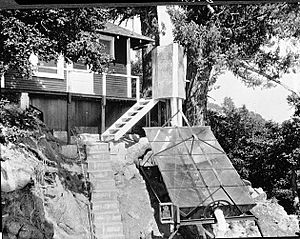
Abbot began his astrophysics research by focusing on the sun's radiation. He then started to map out repeating patterns in how the sun's energy changes. He hoped to track the solar constant (the amount of solar energy reaching Earth) to predict weather patterns. He believed the sun was a variable star that affected Earth's weather. Many scientists at the time disagreed with him.
In 1953, he found a link between solar changes and Earth's climate. This discovery allowed general climate patterns to be predicted 50 years in advance. He did field work at the Smithsonian Institution Shelter. This shelter was built when he was director at SAO. He also worked at Lick Observatory and Mount Wilson Observatory. At Lick, he worked with W.W. Campbell.
To prove his ideas to critics, Abbot used balloons. These balloons had pyrheliometers (tools to measure solar radiation) installed on them. He was the first scientist in America to do this. The balloons went up to 25 kilometers (about 15 miles) high. One balloon sent back data that helped Abbot figure out the solar constant at the highest part of the Earth's atmosphere. Later in his research, he focused on using solar energy.
Abbot was an instrumentalist, meaning he focused on practical tools. He invented the solar cooker, which was first built at Mount Wilson Observatory. He also invented the solar boiler. He held fifteen other patents related to solar energy. For his research and contributions to science, Abbot received the Henry Draper Medal in 1910. He also won a Rumford Medal in 1916.
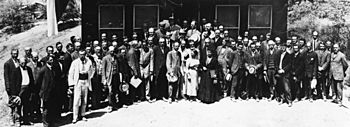
See also
 In Spanish: Charles Greeley Abbot para niños
In Spanish: Charles Greeley Abbot para niños
- List of centenarians (scientists and mathematicians)


